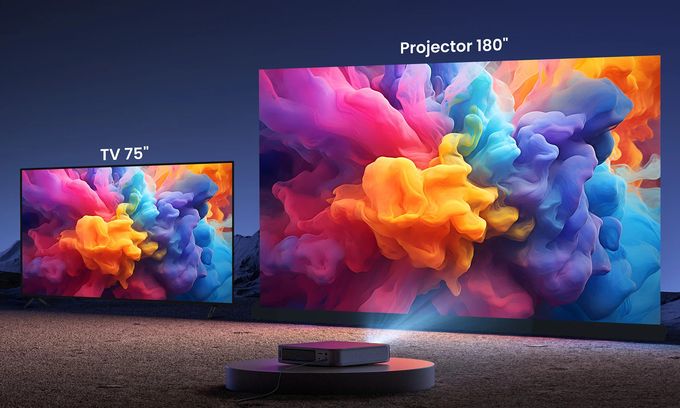For several years now, increasing image size has been a stable trend in the home entertainment device segment. Today, this list includes TVs and projectors. In turn, projectors are divided into ultra-short-throw (UST) and mid-focal.
As known, unlike a mid-focal projector, an ultra-short throw (UST) model creates a large image of 100″ or more diagonally from a very short distance.
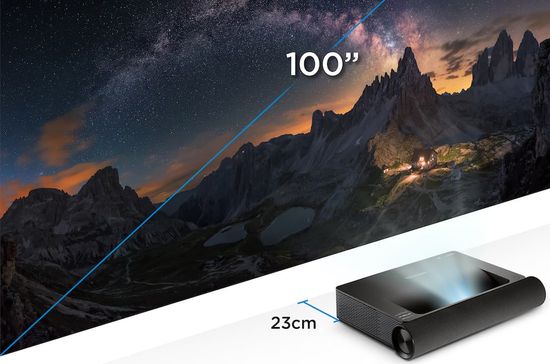
This is achieved by using aspherical mirrors or a cascade of internal lenses to increase the image size.
As a result, UST model is placed very close to the screen on the wall, virtually eliminating the problem of any mid-focal projector with wires on the floor. Frankly speaking, it can only be completely solved with a complex ceiling mount, which radically reduces the projector’s mobility. As a result, the UST design has radically increased the attractiveness of the projector as an alternative to a traditional TV in the living room.
The first LSPX-W1S ‘Life Space’ UST projector was presented by Sony at CES 2014.
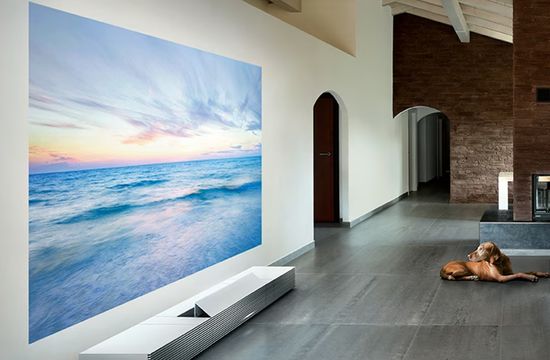
Unfortunately, the more complex design significantly increased the price. In the US it ranged between $ 30,000 and $ 40,000, radically limiting the marketing prospects of the new product. The launch price of the laser Sony VPL-VZ1000ES (discontinued June 2022) was ‘only’ $ 25,000 in 2017, which also did not correspond to the mass consumption segment.
Huge TVs and mid-focal projectors
In fact, the LG PF1000U 1080p was the first affordable model. This model was released October 2015 and discontinued Jan 2018. Its price did not exceed $ 1,500.
Since then, the popularity of UST projectors has grown at a record pace due to the almost complete lack of competition. Indeed, a few years ago, the price of huge 100-inches TVs started at $ 10,000. In turn, mid-focal projectors were inconvenient to move due to their fairly large dimensions and the need for calibration after each move.
Today the situation is changing radically. Not wanting to lose a promising market segment, Samsung, Hisense, LG and TCL have filled this niche in a few years with affordable 100″ TVs, the price of which ranges from $ 2,000 to $ 5,000.
In addition, the huge progress in components and automatic adjustment systems has allowed manufacturers to create mobile and compact mid-focal models, the price of which ranges from $ 1,000 to $ 2,000. For example, the Hisense C2 Ultra supports almost all installation methods.
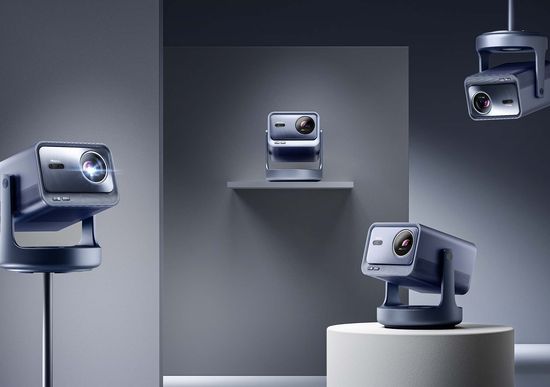
One of the best XGIMI Intelligent Screen Adaption (ISA) 5.0 system almost instantly automatically adjusts the image.
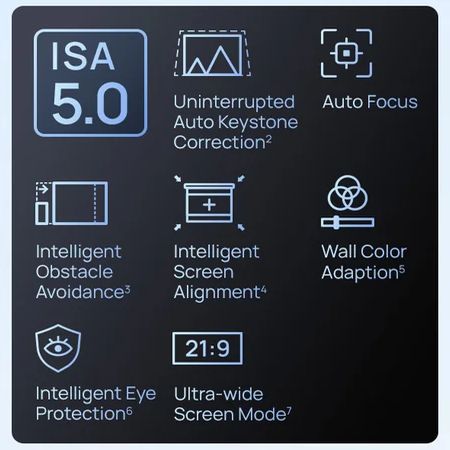
The stand of the new XGIMI Horizon S Pro (XM03Q) provides its adjustment in two planes, which radically simplifies installation.
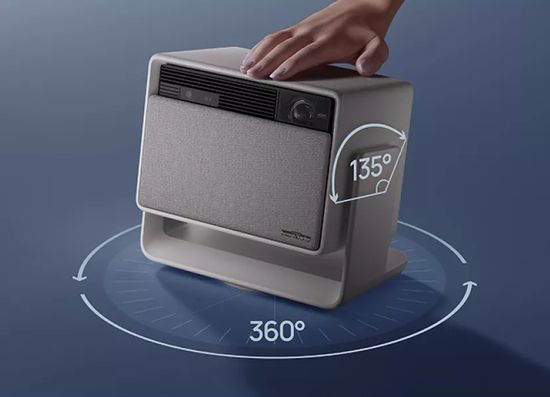
These factors have significantly reduced the price advantage of UST models over TVs and the bonus of convenient installation compared to mid-focus projectors. As a result, the competition between huge TVs, mid-focal and UST projectors has rapidly increased to the delight of consumers.
Huge TV vs UST projector
Of course, the comparison is correct only for models of the same class, including budget, mid-budget and premium segments. The price of mid-budget huge TVs and UST projectors today varies from $ 3,000 to $ 5,000 and from $ 2,500 to $ 3,500, respectively.
The image size of most modern huge TVs is about 100 inches. In fairness, companies sometimes announce 116″ models, but so far this is exotic. The sizes of Micro LED panels with fantastic image quality at a fabulous price of about $ 100,000 in principle have no limitation due to the modular design. But they are beyond competition.
The focusing range of modern projectors can reach several hundred inches. Unfortunately, when specifying the maximum screen size, companies do not always mention the direct dependence of detail and color saturation on the image size. As a rule, modern models provide high enough quality for images up to 120″-150″ diagonally.
In general, huge TVs are inferior to projectors in image size. But this aspect has nuances. According to the recommendations of ophthalmologists, the optimal viewing distance is the screen diagonal multiplied by a factor of 1.3. Accordingly, for a 100-inch image it is 3.4 meters (11.2 ft).
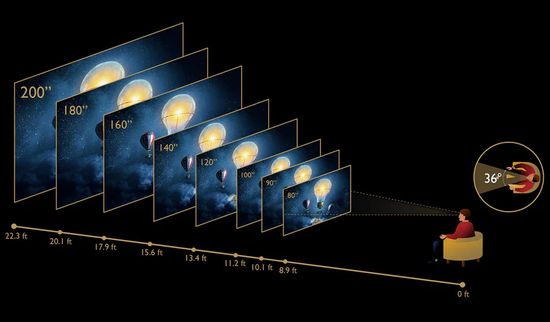
Perhaps, projector placement is not a problem on a spacious oceanfront villa. But for many living rooms in standard apartments, choosing the optimal location can be a difficult task. For example, a small bedroom measuring 3 x 3 is unlikely to be convenient for viewing video content on the 100-inch screen.
Unlike screen size, TVs offer higher brightness and contrast of the image.
Brightness and contrast
The direct light flux from the TV screen surface is brighter compared to the reflected light of the projector. For reference, 1 nit = 3.426 lumens, and 1 lumen = 0.29 nits. The brightness of even budget TVs is 200 – 300 nits, which is slightly less than 1,000 ANSI lumens. The brightness of budget projectors also rarely exceeds 1,000 ANSI lumens. But at the same time, a significant part of the reflected light flux of the projector is scattered. In other segments the situation is similar.
It’s important to compensate for ambient light, which makes the image dim and faded. Therefore, viewing with a low-brightness projector in diffused daylight requires additional darkening with, for example, curtains. But in the evening twilight, the higher brightness of the TV will not be visualized. Of course, it’s also important for the HDR mode. But the very limited assortment of HDR content significantly reduces the importance of this bonus.
LED TVs with Full-Array Local Dimming (FALD), including innovative mini LED – based version or OLED TVs with self-emissive pixels, have radically increased the image contrast. In fairness, LCoS projectors, including JVC D-ILA (Digital Direct-Drive Image Light Amplifier) and Sony SXRD (Silicon X-tal Reflective Display), also provide superb contrast due to ideal black, but they are very expensive. Valerion company successfully solves this problem in another way. Its VisionMaster Pro 2 provides up to 15,000:1 ‘Viewing Contrast’ with Enhanced Black Level or EBL technology.
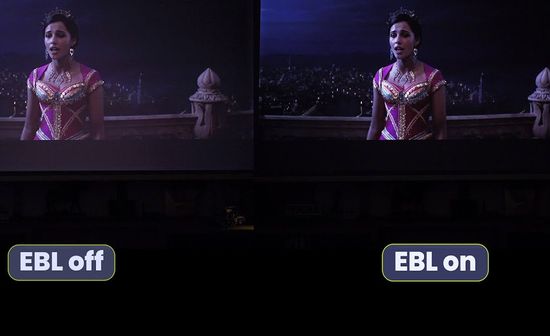
But in general, modern TVs have more contrast. Basically, it affects the saturation of colors in dark scenes. Simply put, a model with high contrast will better reproduce a black detective hiding in a cave in a dark coat and black gloves due to better reproduction of grayscale.
Mid-focal projectors
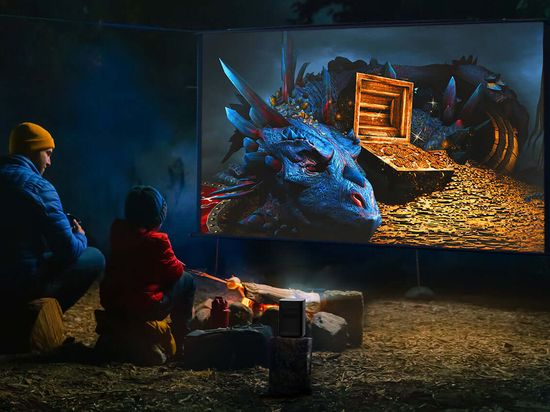
Their price depends significantly on the light engine, which directly affects the model brightness and its color gamut. Basically, modern projectors use:
– Advanced Laser Phosphor Display (ALPD) 3.0 – based light source (single laser + phosphor with color gamut up to 100% DCI-P3);
– ALPD 4.0 – based version (RGB Triple Laser with color gamut up to 110% BT.2020);
– hybrid schemes (ALPD 5.0 – 3 LEDs + 3 lasers, RGB+Phosphor and other with wider coverage and reduced laser speckles).
Mid-focal projectors:
– JmGO Picoflix 1080p – $ 450, LED, 450 ANSI Lumens;
– Samsung Freestyle 2nd gen 1080p – $ 600, LED, 230 ANSI Lumens;
– Epson Epiqvision Mini EF-22 / EF-21 – $ 900 / $ 775, Single Laser + Phosphor, 1,000 ISO Lumens;
– LG CineBeam PU700R – $ 1,500, LED, 1,000 ANSI Lumens;
– ViewSonic LX700-4K – $ 1,500, Single Laser + Phosphor, 3,500 ANSI Lumens;
– XGIMI Horizon Ultra – $ 1,700, hybrid Dual Light source, 2,300 ANSI Lumens;
– BenQ GP500 – $ 1,800, LED, 1,500 ANSI Lumens;
– Dangbei DBOX02 Mars Pro 2 – $ 1,900, Single Laser + Phosphor, 2,450 ISO Lumens;
– BenQ W2720i – $ 2,000, LED, 2,500 ANSI Lumens;
– Valerion VisionMaster Max / Pro 2 / Plus 2 ~ $ 2,200 / $ 2,100 / $ 1,500, RGB Triple-Laser, >- 3000 / 3000 / 2000 ISO Lumen;
– Hisense C2 Ultra – $ 2,500, RGB Triple-Laser, 3,000 ANSI Lumens;
– JVC DLA-NZ500 – $ 6,000, 40,000:1 contrast ratio with LCoS technology, Single Laser + Phosphor, 2,000 ANSI Lumens.
UST projectors
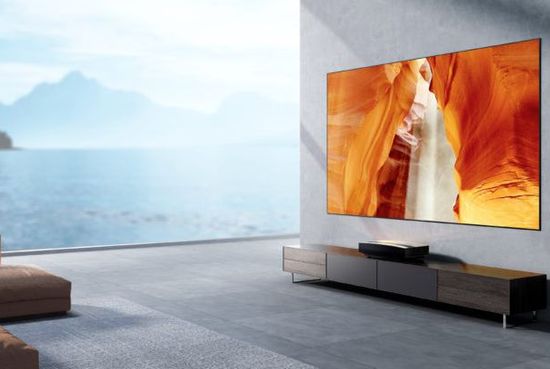
– WEMAX Nova SE – $ 1,350, Single-Laser + Phosphor, 1,300 ANSI Lumens;
– Optoma GT3500HDR 1080p – $ 1,370, Single-Laser+Phosphor, 3,800 Lumens;
– Nomvdic P2000 – $ 1,800, RGB Triple Laser, 2,500 Lumens;
– Formovie Cinema Edge – $ 1,800, Single-Laser+Phosphor, 1,900 Lumens;
– AWOL Vision LTV-3500 Pro / 3000 Pro / 2500 – $ 6,000 / $ 3,200 / $ 2,500, RGB Triple Laser, 3,000 / 2,000 / 1,700 Lumens;
– Hisense PL2 – $ 2,000, Single-Laser+Phosphor, 2,700 Lumens;
– Nexigo Aurora Pro / Lite – $ 2,500 / $ 2,000, RGB Triple Laser, 2,400 / 1,900 Lumens;
– Epson EpiqVision Ultra LS800 / LS650 / LS300 – $ 3,000 / $ 1,800 / $ 2,000, Single-Laser + Phosphor, 4,000 / 3,600 / 3,600 Lumens;
– ViewSonic X2000B-4K – $ 2,200, Single-Laser + Phosphor, 2,000 Lumens;
– XGIMI Aura 2 – $ 2,700, RGB+Phosphor Hybrid, 2,300 Lumens;
– LG CineBeam HU715QW – $ 3,000, Single Laser+Phosphor, 2,500 Lumens;
– BenQ V5010i – $ 3,000 MSRP, RGB Triple-Laser, 2,500 Lumens;
– Formovie Theater Premium – $ 3,000, RGB Triple-Laser, 2,200 Lumens;
– Samsung ‘The Premiere’ 9 LPU9D / 7 LPU7D – $ 5,830 / $ 2,750, RGB Triple-Laser, 3,200 / 2,400 Lumens;
– Hisense PX3-Pro – $ 3,365, RGB Triple-Laser, 3,000 Lumens;
– Ultimea Thor T60 / T50 – $ 5,000 / $ 4,000 MSRP, RGB Triple-Laser / Single Laser + Phosphor, 4,000 Lumens / 3,000 Lumens;
– LG Cinebeam HU915QB/HU915QE – $ 5,750 / $ 5,870, Triple Laser+Phosphor, 3,000 /3,700 Lumens.
UST vs mid-focal projectors
With the exception of the JmGO Picoflix and Samsung Freestyle with 1080p resolution, and a few LED models with limited brightness, prices in the lower part of the premium-segment range from $ 1,500 to $ 2,000. An analysis in a similar segment of UST projector shows a range from $ 1,800 to $ 2,500. Thus, UST models are more expensive than mid-focal projectors with similar specs by several hundred dollars, which is 15-20%. This is probably quite an adequate additional price for a simple and convenient installation near the screen.
Additionally, in recent years, manufacturers have significantly reduced the weight and size of the mid-focal models, introducing quite powerful and bright compact projectors. For example:
– Epson Epiqvision Mini EF-21 – 2.4 kg / 5.3 lbs;
– Dangbei Mars Pro 2 – 4.0 kg / 8.8 lbs;
– Dangbei X5 Ultra – 5.15 kg / 11.35 lbs;
– XGIMI Horizon Ultra 5.2 kg / 11.4 lbs.
For comparison (UST):
– XGIMI Aura 2 – 9 kg / 19.8 lbs;
– Hisense PX3-Pro – 9 kg / 19.8 lbs;
– Nexigo Aurora Pro – 10 kg / 22.0 lbs.
Photos of new XGIMI models clearly demonstrate the difference in sizes.
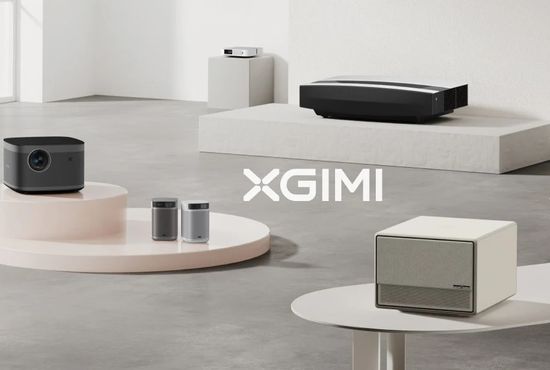
Of course, their smaller weight and dimensions provide them with better mobility. Even a teenager can easily carry a 5 kg projector, for example, from a room to the yard.
Conclusion
Thus, the market offers several solutions for home theater lovers:
– huge 100-inches TVs;
– mid-focal projectors;
– UST (ultra-short throw) projectors.
Traditionally, each of them has its pros & cons. In particular, due to the higher TV brightness, their image quality is higher in HDR mode and in ambient lighting. The higher contrast provides good color saturation and detail in dark scenes. But their screen size is limited to 100 inches diagonally. In addition, they are slightly more expensive than projectors of the same class. In particular, for the lower premium segment, the price range is in the $ 2,000 to $ 5,000 range vs $ 1,800 to $ 2,500 for UST projectors.
The mid-focal projectors are cheaper ($ 1,500 – $ 2,000), compact and have a focusing range of up to 150″. But they form an image from a distance of several meters, creating the problem of wires on the floor when installed in room center. It can only be solved with a ceiling mount, which is difficult and radically reduces their mobility.
UST projectors today can be positioned as an optimal compromise. At a price of $ 1,800 – $ 2,500, they offer convenient placement near a wall with a screen, a huge image and fairly high image quality.
But a huge image requires a spacious room. In particular, taking into account the recommendations of ophthalmologists, the optimal viewing distance is approximately 1.3x the screen diagonal (~ 4 meters for 100″). For many living rooms, choosing installation and viewing locations can be a problem.
Hisense introduced 136-inch TriChromaLED TV and 136-Inch MicroLED panel at CES 2025.
